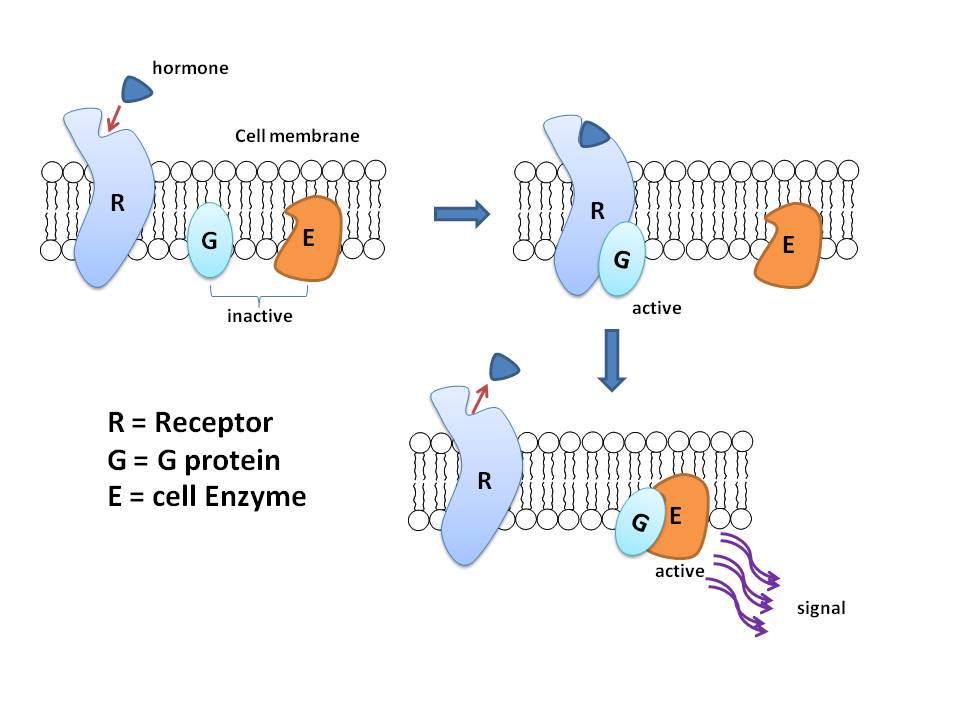Structural Biochemistry/G Proteins
G-protein coupled receptors GPCR) is transmembrane receptor protein that stimulates a GTP-binding signal transducer protein(G-protein)which in turn generates an intracellular receptor. GPCR is large family of receptors that transmembrane protein that is serpentine in shape, crossing the lipid bilayer seven times. G-protein have two major groups:
1. Small GTP binding protein.
2. Heterotrimeric G protein(directly coupled to receptor and enzyme)
R have alpha, beta and gramma subunit. An alpha subunit contains the GTP/GDP binding site, to identify beta and gramma subunits. A hormone called epinephrine triggers the communication between inner parts of cells to pass cellular messages. The signal transduction, in detail, is occurred in three distinct steps. First, epinephrine message makes contact with the receptor on the surface of the cell. Second, the connecting transducer, the one with the role of switch, passes the message inward. Lastly, the signal gets amplified and it stimulates the cell to do its work.
Overall, G Proteins simply act as a switch in the process of cell signaling. Put another way, it is the baton in the relay of cell-signaling. However, they must be activated (turned on) only when needed and deactivated (turned off) immediately. If the G protein is left on at all times, illnesses and fatal diseases can and may occur. A G-protein may be left on in the active conformation even in the absence of ligand binding, leading to improper regulation of the proteins. Such fatal diseases that arise from improper regulation of the G-proteins include cholera: a life-threatening condition that occurs when the G-protein controlling water balance is left uncontrollably on. The result of this pathway kept aberrantly on leads to continuous diarrhea which becomes increasingly dangerous to the individual's well-being. [1] [2]
Nobel Prize Winners
editThis switch was named G-protein by the 1994 Nobel Prize Winner Alfred G. Gilman from the University of Texas Southwestern Medical Center in Dallas. The name came not from his last name, but from the energy source of these G-proteins: GTP (Guanosine Tri-Phosphate). This discovery sparked considerable activity in further research of this molecule because it gives helpful clues to how cell-signaling works. The impact of this discovery still remains influential, as scientists continue to pay close attention to this molecule today. In 2012, Robert J. Lefkowitz and Brian K. Kobilka were awarded the Nobel Prize in Chemistry for their study of the G-protein coupled receptors, specifically on their studies of its three-dimensional structure.
- ↑ Berg, Jeremy M., ed. (2002), Biochemistry (6th ed.) New York City, NY: W.H. Freeman and Company,
- ↑ Davis, Alison, Ph.D., (2006), Medicines By Design: The G Switch (NIH Publication No. 06-474): U.S. DEPARTMENT OF HEALTH AND HUMAN SERVICES,
- ↑ Davis, Alison, Ph.D., (2006), Medicines By Design: The G Switch (NIH Publication No. 06-474): U.S. DEPARTMENT OF HEALTH AND HUMAN SERVICES,
- ↑ "The Nobel Prize in Chemistry 2012". Nobelprize.org. 22 Nov 2012 http://www.nobelprize.org/nobel_prizes/chemistry/laureates/2012/
